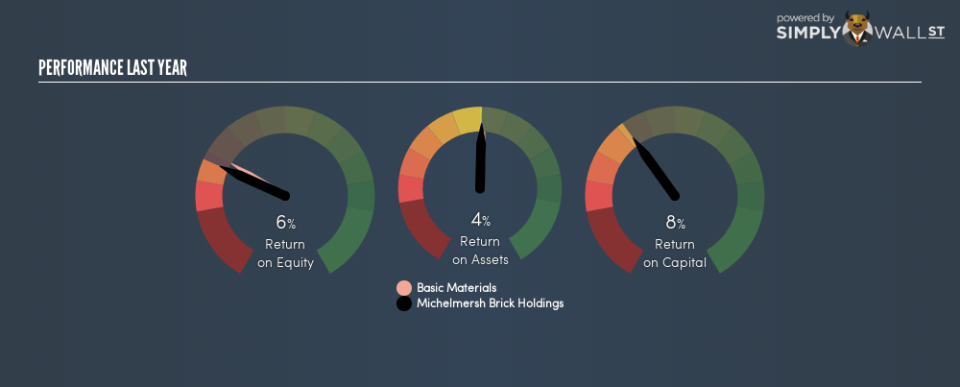Why Michelmersh Brick Holdings plc’s (LON:MBH) Return On Capital Employed Might Be A Concern

Today we’ll evaluate Michelmersh Brick Holdings plc (LON:MBH) to determine whether it could have potential as an investment idea. In particular, we’ll consider its Return On Capital Employed (ROCE), as that can give us insight into how profitably the company is able to employ capital in its business.
First up, we’ll look at what ROCE is and how we calculate it. Second, we’ll look at its ROCE compared to similar companies. And finally, we’ll look at how its current liabilities are impacting its ROCE.
Return On Capital Employed (ROCE): What is it?
ROCE measures the ‘return’ (pre-tax profit) a company generates from capital employed in its business. All else being equal, a better business will have a higher ROCE. Ultimately, it is a useful but imperfect metric. Author Edwin Whiting says to be careful when comparing the ROCE of different businesses, since ‘No two businesses are exactly alike.’
How Do You Calculate Return On Capital Employed?
Analysts use this formula to calculate return on capital employed:
Return on Capital Employed = Earnings Before Interest and Tax (EBIT) ÷ (Total Assets – Current Liabilities)
Or for Michelmersh Brick Holdings:
0.077 = UK£5.0m ÷ (UK£97m – UK£11m) (Based on the trailing twelve months to June 2018.)
So, Michelmersh Brick Holdings has an ROCE of 7.7%.
View our latest analysis for Michelmersh Brick Holdings
Want to help shape the future of investing tools and platforms? Take the survey and be part of one of the most advanced studies of stock market investors to date.
Does Michelmersh Brick Holdings Have A Good ROCE?
One way to assess ROCE is to compare similar companies. In this analysis, Michelmersh Brick Holdings’s ROCE appears meaningfully below the 10.0% average reported by the Basic Materials industry. This performance could be negative if sustained, as it suggests the business may underperform its industry. Setting aside the industry comparison for now, Michelmersh Brick Holdings’s ROCE is mediocre in absolute terms, considering the risk of investing in stocks versus the safety of a bank account. It is possible that there are more rewarding investments out there.
When considering ROCE, bear in mind that it reflects the past and does not necessarily predict the future. Companies in cyclical industries can be difficult to understand using ROCE, as returns typically look high during boom times, and low during busts. ROCE is, after all, simply a snap shot of a single year. Future performance is what matters, and you can see analyst predictions in our free report on analyst forecasts for the company.
What Are Current Liabilities, And How Do They Affect Michelmersh Brick Holdings’s ROCE?
Current liabilities are short term bills and invoices that need to be paid in 12 months or less. The ROCE equation subtracts current liabilities from capital employed, so a company with a lot of current liabilities appears to have less capital employed, and a higher ROCE than otherwise. To counter this, investors can check if a company has high current liabilities relative to total assets.
Michelmersh Brick Holdings has total assets of UK£97m and current liabilities of UK£11m. Therefore its current liabilities are equivalent to approximately 11% of its total assets. This is a modest level of current liabilities, which would only have a small effect on ROCE.
What We Can Learn From Michelmersh Brick Holdings’s ROCE
If Michelmersh Brick Holdings continues to earn an uninspiring ROCE, there may be better places to invest. Of course, you might find a fantastic investment by looking at a few good candidates. So take a peek at this free list of companies with modest (or no) debt, trading on a P/E below 20.
For those who like to find winning investments this free list of growing companies with recent insider purchasing, could be just the ticket.
To help readers see past the short term volatility of the financial market, we aim to bring you a long-term focused research analysis purely driven by fundamental data. Note that our analysis does not factor in the latest price-sensitive company announcements.
The author is an independent contributor and at the time of publication had no position in the stocks mentioned. For errors that warrant correction please contact the editor at editorial-team@simplywallst.com.

